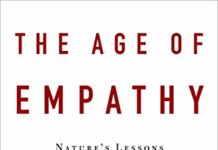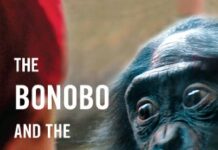
Ebook Info
- Published: 2009
- Number of pages: 230 pages
- Format: PDF
- File Size: 4.91 MB
- Authors: Frans de Waal
Description
Can virtuous behavior be explained by nature, and not by human rational choice? “It’s the animal in us,” we often hear when we’ve been bad. But why not when we’re good? Primates and Philosophers tackles this question by exploring the biological foundations of one of humanity’s most valued traits: morality. In this provocative book, renowned primatologist Frans de Waal argues that modern-day evolutionary biology takes far too dim a view of the natural world, emphasizing our “selfish” genes and reinforcing our habit of labeling ethical behavior as humane and the less civilized as animalistic. Seeking the origin of human morality not in evolution but in human culture, science insists that we are moral by choice, not by nature. Citing remarkable evidence based on his extensive research of primate behavior, de Waal attacks “Veneer Theory,” which posits morality as a thin overlay on an otherwise nasty nature. He explains how we evolved from a long line of animals that care for the weak and build cooperation with reciprocal transactions. Drawing on Darwin, recent scientific advances, and his extensive research of primate behavior, de Waal demonstrates a strong continuity between human and animal behavior. He probes issues such as anthropomorphism and human responsibilities toward animals. His compelling account of how human morality evolved out of mammalian society will fascinate anyone who has ever wondered about the origins and reach of human goodness. Based on the Tanner Lectures de Waal delivered at Princeton University’s Center for Human Values in 2004, Primates and Philosophers includes responses by the philosophers Peter Singer, Christine M. Korsgaard, and Philip Kitcher and the science writer Robert Wright. They press de Waal to clarify the differences between humans and other animals, yielding a lively debate that will fascinate all those who wonder about the origins and reach of human goodness.
User’s Reviews
Reviews from Amazon users which were colected at the time this book was published on the website:
⭐This book is written in a unique style in that it is almost like you are attending an academic conference on the topic as it is presented by different people. You get to read de Waal’s insights and then hear others counter or agree with his positions on animals and morality. The book has some good thoughts but I much prefer the most recent books that de Waal has written and I would recommend starting there first as they are much more interesting and comprehensive. Because I have read those, I was able to follow this a little better. The presentation of the material is okay but not as it is for his other books or other science books. Overall, I’m glad I read it, but would suggest starting with a different book first before picking this up.
⭐This is a great book if only because it provides views from five different scholars. “In the Tanner Lectures on Human Values that became the lead essay in this book, Frans de Waal brings his decades of work with primates, and his habit of thinking deeply about the meaning of evolution, to bear upon a fundamental question about human morality. Three distinguished philosophers and a prominent student of evolutionary psychology then respond to the way de Waal’s question is framed, and to his answer. Their essays are at once appreciative of de Waal’s endeavor and critical of certain of his conclusions. De Waal responds to his critics in an afterword.”The main thrust of de Waal’s essay is what he calls “Veneer Theory,” which is the argument that morality is only a thin veneer overlaid on an amoral or immoral core. The first to respond is Robert Wright (
⭐), who states that he is in fact not an adherent to de Waal’s Veneer Theory. Second is Christine M. Korsgaard (
⭐), who denies that Veneer Theory is even real. Third is Philip Kitcher (
⭐), who generally attacks Veneer Theory as not being relevant to bridging the divide between primates and humans. The fourth, last, and my personal favorite, comes from Peter Singer (
⭐). Singer, I believe, does the greatest justice to the entire argument and I happen to agree with almost everything he says. Singer states, “The issue, then, is not so much whether we accept the Veneer Theory of morality, but rather how much of morality is veneer, and how much is underlying structure. Those who claim that all of morality is a veneer laid over a basically individualistic, selfish human nature, are mistaken. Yet a morality that goes beyond our own group and shows impartial concern for all human beings might well be seen as a veneer over the nature we share with other social mammals.”In conclusion, I think this is a valuable book and do recommend it. I would also recommend getting Michael Tomasello’s
⭐as it is similar in nature and style. Lastly, I would also mention that Frans de Waal mentions a research experiment in which he “demonstrates” primate empathy, but as Tomasello points out, “But studies [contra de Waal] from three different laboratories in the case of the capuchins, and from our laboratory in the case of the chimpanzees, have all found that this is a spurious result in that it does not depend on a social comparison at all. One of the studies found that simply seeing and expecting to receive the grape makes the cucumber look less attractive to chimpanzees. No other individuals need to be around. There is no social comparison going on, only food comparison. So nothing related to norms of fairness are at work either (pg. 32).” Hope that helps.
⭐Primates and Philosophers is not a comprehensive analysis of the origins of morality, but focuses on one minutia of the subject: whether human morality goes deep into our evolutionary past or is new with the arrival of our bulbous brains and cultures. The answer depends on how morality is defined. If moral behavior falls under the definition of morality, it seems clear that other primates such as chimps share at least rudimentary moral behavior. But if morality is defined as abstract thinking about right and wrong and living by principles derived abstractly, then morality must be pretty recent in humans’ evolutionary past.De Waal quotes Richard Dawkins as saying “we, alone on earth, can rebel against the tyranny of the selfish replicators” and “[we are] nicer than is good for our selfish genes.” De Waal takes this as lending support of what he calls ‘veneer theory’, the position that morality is “a cultural overlay, a thin veneer hiding an otherwise selfish and brutish nature.” Having read seven of Richard Dawkins’ books, I feel like I understand his views pretty well, and I don’t think he would agree with veneer theory at all. I think there is some ambiguity here between proper domain vs. actual domain. The proper domain is the conditions under which a behavior evolved, and the actual domain is the conditions under which the behavior is manifest. Sometimes they are the same, sometimes not. For example, the proper domain of a moth’s light-sensitive navigation system is a light source in the dark that an ancient moth would have encountered, such as the moon. But today, the actual domain may be a light bulb, candle, or bug zapper. The navigation system doesn’t work correctly when the source of light is nearby, and it causes moths to spiral into light sources, sometimes to their deaths. Our genes (and moth genes) provide rules-of-thumb that aren’t necessarily survival-enhancing in every conceivable actual domain; it is only necessary that these rules were useful on average to our ancestors in our evolutionary past. So saying that we are “nicer than is good for our selfish genes” in the world we currently live in, which is much different than our evolutionary past, is not to imply some mysterious cause outside of nature accounts for this deviation. Similarly, every time we use contraception we are “rebelling against the tyranny of the selfish replicators” because the proper domain (in the technical sense) of sex is procreation, but the actual domain may be recreation. Having as many offspring as possible would be beneficial to our genes, but we can obviously choose not to do so.In a table on page 22, de Waal compares veneer theory to his own theory of the evolution of ethics. Under veneer theory, he lists Richard Dawkins as an advocate and states that the empirical evidence in favor of that theory is “none.” This is a textbook straw man, and I am confident that at least one of the alleged “advocates” is no advocate at all.On the next page, de Waal hastily concludes that Steven Pinker’s brilliant work on human language skills requires “postulating discontinuities” in evolution and thus is saltatory. Apparently he takes it as self-evident that a language module in the brain cannot possibly evolve by gradual degrees, although I’m baffled as to why he thinks that.In Christine Korsgaard’s section, she writes “it is absurd to think that nonhuman animals are motivated by self-interest…acting for the sake of your best interests requires the capacity to be motivated by the abstract conception of your overall long-term good.” [p 102] Self interest, I think, can be pretty simply defined as the most effective way of spreading your genes. There is no need to have a conscious conception of what that consists of because the genes that program the best gene-spreading behavior are automatically propagated. I found Korsgaard’s chapter to be lacking in scientific rigor. She seemed to make conclusions about empirical questions based on casual observation and reasoning. However, she did provide a clear definition of morality which was lacking from de Waal’s part.In Phillip Kitcher’s section, he defines four dimensions of ‘altruism space’: intensity (the degree to which one meets the needs or desires of others), range (how high can the stakes get before one acts selfishly), extent (the set of individuals one acts altruistically toward), and skill (ability to discern the desires of the beneficiary). He agrees that non-human primate morality lies somewhere in the defined ‘altruism space’ away from pure selfishness, but until we have a clear definition of the ideal moral individual with respect to these four dimensions, “it’s premature to claim that human morality is a ‘direct outgrowth’ of tendencies [non-human primates] share.” [p 129] But if non-human primate morality differs by degree and not by kind (as implied here) is it not reasonable to conjecture that human morality is a direct outgrowth of the tendencies of primates?Kitcher goes on to say that when chimpanzees are faced with an opportunity for altruism, their impulses for selfishness and altruism duke it out and they are ultimately “vulnerable to whichever impulse happens to be dominant at a particular moment.” But I am far from convinced that humans are much different. Since when have we humans overcome our impulses? As Peter Singer argues later in the book, our emotional impulses constitute a large part of our morality. In those rare cases where abstract thinking overturns our gut reactions to moral questions, one could argue we are not acting on impulse but on reason. But those cases probably represent a vast minority of moral judgments. As de Waals mentioned, moralistic and altruistic intuitions come from deep in the evolutionarily ancient part of the brain, and conscious rationalization of those intuitions does not mean we’ve overcome them. Steven Pinker has revealed a world in which unconscious brain processes have profound impacts on our thoughts and decisions even though, by definition, we don’t notice them. But we surely notice when they’re gone, such as in people who have suffered damage to various parts of the brain, leaving certain parts of the intellect unscathed while some capacities are completely destroyed.Peter Singer’s section was the highlight of this book. I found his section better-argued than the others and his explanations more compelling. “Like the other social mammals, we have automatic, emotional responses to certain kinds of behavior, and these responses constitute a large part of our morality. Unlike the other social mammals, we can reflect on our emotional responses, and choose to reject them.” [p 149] “Perhaps we do so only on the basis of other emotional responses, but the process involves reason and abstraction.” Singer points out that this ability to reflect and abstract is evolved not just to make moral choices but is useful in many other parts of life as well.
⭐The earlier reviews posted by Ashtar Command and Stephen A Haines provide very good summaries of the arguments advanced in this book, so I will not repeat them here. I would only stress that the comments in Part Two are those of a group of philosophers all of whom accept that Homo sapiens and the great apes evolved from a common ancestor through natural selection. This means that there is no attempt to invoke religious explanations for human moral exceptionalism (such as it is!). Secondly, all accept that moral goodness is a reality about which truth claims can be made – so moral relativism is given short shrift.If, like me, you are happy with these constraints, you may find de Waal’s arguments almost irresistible – the contrast between de Waal’s empirically-based observations and the “thought experiments” and definitional quibbling of the philosophers is especially telling.Whilst most of the material that de Waals describes appears in more – and more satisfying – detail in his earlier book, “The Bonobo and the Atheist”, this volume does represent an interesting attempt to create a genuine dialogue between “science” and more purely academic philosophy. It might also act as a useful corrective to those who misinterpret the notion of “selfishness” in its biological, Darwinian sense.Highly recommended.
⭐Frans De Waal is a primatologist, he studies the behaviour of primates and has proven by experiments that the building blocks of human moral behaviour come from our not so distant cousins. Empathy, sympathy and reciprocation are evident in the behaviour of our closest related primates, a very interesting book that is also self critical, half the book is donated to critique of De Waals interpretation of his theories an interesting and important read that will unfortunately not be read by the people who need to read it.
⭐Great book, challenging the prevailing view that human nature is bad. Rather we have innate senses of fairness and intrinsic equality: not equality of fact, because we are all different, but equality of principle – behaving to each other in a decent way.
⭐A good response to those who consider humans unique in some mysterious way and not the product of animal evolution.
⭐You should come to this having read de Waal’s earlier books on chimpanzees and bonobos. If you have, you will find that this takes you further in your thinking. I’m not sure that the dialogue between de Waal and his critics (in the second half of the book) is all that enlightening in places. They seem to talk past each other at times. However, it gives you a good feel for the important issues in this area and makes you think productively. Whilst the topic can seem as though it is more for the specialist, it is easily accessible by the intelligent lay reader.
Keywords
Free Download Primates and Philosophers: How Morality Evolved (The University Center for Human Values Series Book 30) in PDF format
Primates and Philosophers: How Morality Evolved (The University Center for Human Values Series Book 30) PDF Free Download
Download Primates and Philosophers: How Morality Evolved (The University Center for Human Values Series Book 30) 2009 PDF Free
Primates and Philosophers: How Morality Evolved (The University Center for Human Values Series Book 30) 2009 PDF Free Download
Download Primates and Philosophers: How Morality Evolved (The University Center for Human Values Series Book 30) PDF
Free Download Ebook Primates and Philosophers: How Morality Evolved (The University Center for Human Values Series Book 30)



